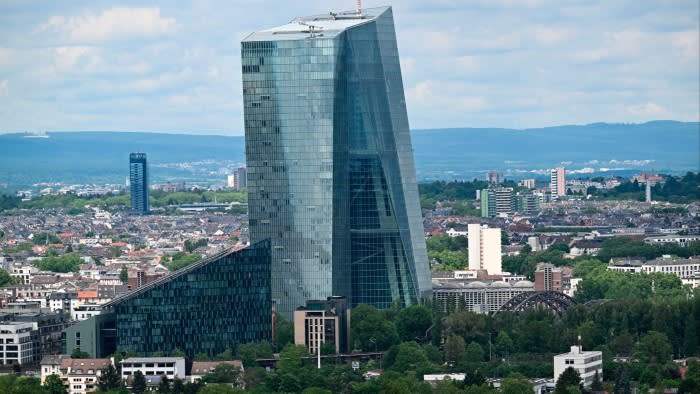Unlock Editor’s Digest for free
FT editor Roula Khalaf picks her favorite stories in this week’s newsletter.
The European Central Bank sent a clear signal it will cut interest rates from their record highs next week, as its chief economist brushed off concerns it could reverse before the U.S. central bank might.
The ECB now looks almost certain to be one of the first major central banks to cut rates, having been criticized for being one of the last to raise them after the biggest surge in inflation in a generation three years ago.
Philip Lane told the Financial Times in an interview ahead of the bank’s landmark meeting on June 6: “Without any big surprises, there is enough in what we are seeing at the moment to remove the top level of restraint.”
Investors are betting heavily on the ECB to cut its key deposit rate by a quarter of a percentage point from a record 4 percent at next week’s meeting after euro zone inflation fell close to the bank’s 2 percent target.
Swiss, Swedish, Czech and Hungarian central banks have cut borrowing costs this year in response to falling inflation. Among the world’s major economies, however, the Fed and the Bank of England are not expected to cut rates before the summer, and the Bank of Japan is seen as more likely to raise them further.
Asked if he was proud of the ECB’s ability to cut rates earlier than others, Lane said: “Central bankers try to be as boring as possible, and I hope central bankers aspire to have as few egos as possible.”
He added that a key reason why inflation fell faster in the eurozone than in the US was that the region was hit harder by the energy shock caused by Russia’s invasion of Ukraine. “Dealing with the war and the energy problem has been costly for Europe,” he said.
“But as for that first step. [in starting to cut rates] this is a sign that monetary policy is ensuring that inflation falls in a timely manner. In that sense, I think we’ve been successful.”
Lane said ECB policymakers need to keep rates in restrictive territory this year to ensure inflation continues to fall and does not get stuck above the bank’s target, which he said “would be very problematic and probably very painful to remove”.
But he said the pace at which the central bank has cut borrowing costs in the eurozone this year will be decided based on an evaluation of the data to decide “whether it’s proportionate, it’s safe to move down within the restrictive zone”.

“Things are going to be bumpy and things are going to be gradual,” said Lane, who is responsible for drafting and presenting the proposed rate decision before the 26-member cabinet decides on it next week.
“The best way to frame this year’s debate is that we still need to be restrictive throughout the year,” he added. “But we can move down somewhat in the containment zone.
In a speech on Monday, Lane said: “The subsequent pace of rate cuts will be slower if there are surprise increases in core inflation. . . and the level of demand,” but will be “faster if there are downside surprises” about inflation and demand. He went on to tell reporters at the Dublin event: “The discussion of rate cuts next week is not a declaration of victory.
Despite recent data showing eurozone wage growth accelerated to a near-record pace at the start of this year, Lane said “the overall direction of wages still points to a slowdown, which is fundamental”, adding that the ECB’s own support has been given. salary tracker.
Some analysts warned that if the ECB deviated from the Fed by cutting rates more aggressively, it could cause the euro to depreciate and increase inflation by raising the price of imports into the bloc.
Lane said the ECB would take into account any “significant” movement in the exchange rate, but pointed out that “there has been very little movement in that direction”. The euro has bounced back by a fifth against the US dollar from a six-month low in April and remains up over the past year.
Instead, he said a delay in the expected timing of the Fed’s rate cut had pushed up US bond yields and that had lifted long-term European bond yields.
“This mechanism means that for any interest rate we set, you get an additional tightening from US conditions,” he said, hinting that the ECB may have to offset this with an additional cut in the short-term deposit rate. “All things being equal, if the long end gets tighter, it changes the way you think about the short end.”

Eurozone inflation fell from more than 10 percent at its peak in 2022 to a near three-year low of 2.4 percent in April, but is expected to rise to as high as 2.5 percent when May data is released this week.
Lane said “still considerable cost pressures” from fast wage growth pushing up service prices meant the ECB would need to keep policy tight until 2025.
“Next year, when inflation is visibly close to the target, then making sure the interest rate comes down to a level consistent with that target – that will be a different debate,” he said.
How far the ECB cuts rates overall will depend on its assessment of the so-called neutral rate, the point where savings and investment are balanced at desired levels, when output is at the economy’s potential and target inflation.
Estimates of the neutral rate vary, but Lane said that would likely mean a policy rate at or just above 2 percent, although it could be higher if there is a “vigorous green transition” to renewables or huge gains from generative artificial intelligence caused a surge. in investments.
More news from Jude Webber in Dublin
